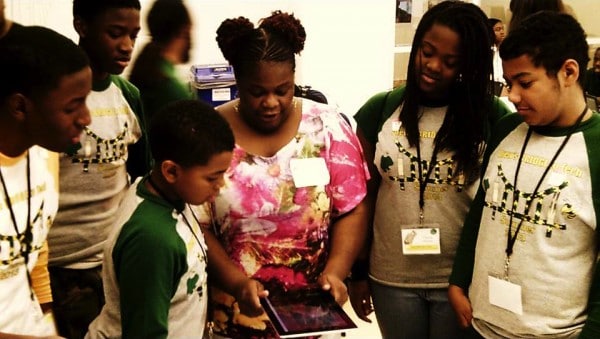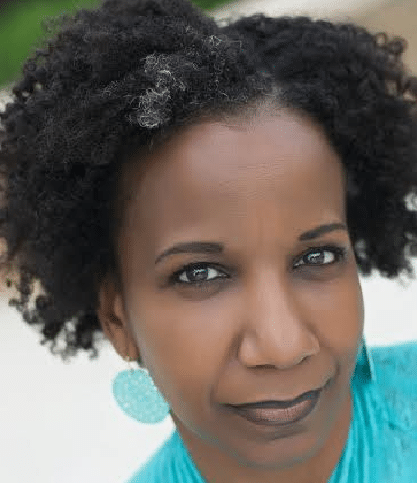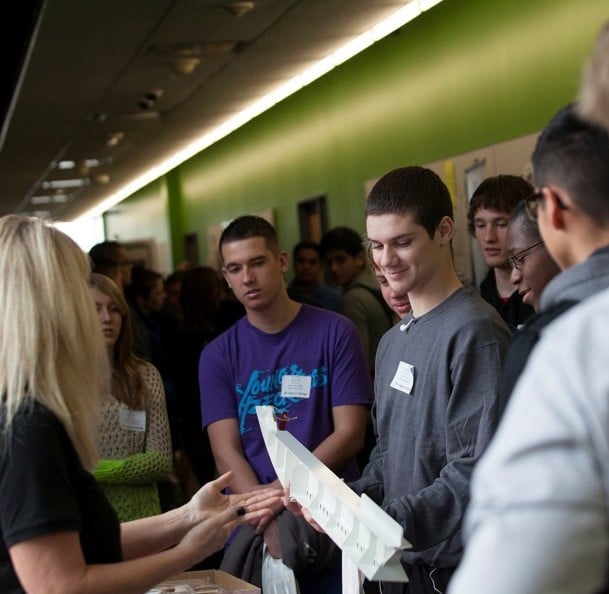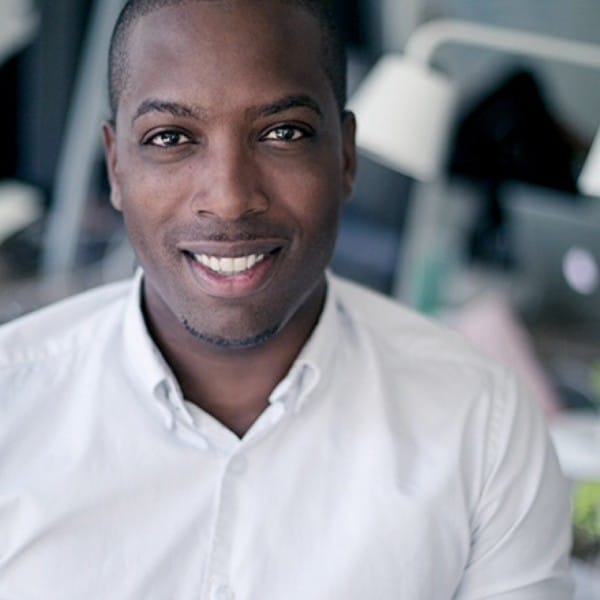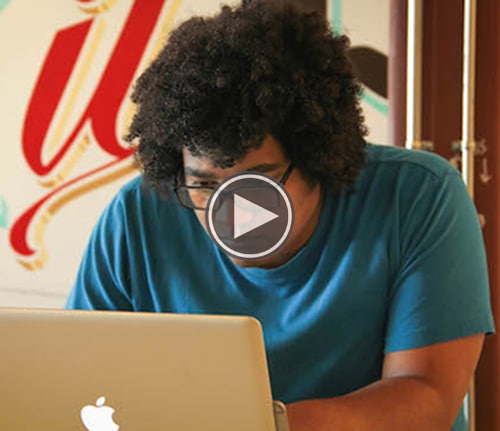Source: USA Today
Using STEAM to Move Marginalized Students into the Future: An Interview with Dr. Nettrice Gaskins
You may have heard of STEM (Science, Technology, Engineering and Math) subjects, but more and more programs are beginning to focus on STEAM (STEM + Art), recognizing the importance of art and design in education, research and policy. Dr. Nettrice Gaskins, STEAM education lab director at Boston Arts Academy, investigates culturally situated arts-based learning and new media and how they are developed and practiced in creative communities. In addition to her extensive work in the STEAM field, she frequently writes about and advances theory and research on Black futurism, digital technologies, art and music. In this interview, Gaskins offers her thoughts on Afrofuturism, race, technology, art and where it all intersects out in the real world.
How do you define technology? Where do art and technology cross paths?
Technology comes from a Greek word (teche) that translates as art, skill, cunning of hand and another word (logia) that means I speak. This makes me think of Public Enemy’s Terminator X Speaks With His Hands, or Sun Ra’s use of different instruments such as early electronic keyboards. Art and music, in of themselves, are products, but you need a tool, system or platform with which to extrapolate, communicate and amplify that information. That’s how an art form becomes technology. Technology is the making, modification, usage and knowledge of tools, systems or platforms to solve problems or improve a pre-existing solution to a problem. Take, for example, the problem of race: Ta-Nehisi Coates writes about race as a social construct and Beth Coleman writes about race as technology. Both are correct; we have constructed tools, systems and platforms to characterize race. I explored the idea of “race as technology” in my Art21 post, Black Futurism: The Creative Destruction and Reconstruction of Race in Contemporary Art, specifically how African-American artists trouble the notion of race.
One criticism about Afrofuturism is that it does not advance technology or dream up novel technologies that can have practical, real-life applications. What are your thoughts on this critique?
One of the early scholars of Afrofuturism, Alondra Nelson, co-wrote Technicolor: Race, Technology, and Everyday Life. In the book, she asserts that it is necessary to use a broader understanding of technology, and to include not only those thought to create revolutions (e.g. information technologies), but also those with which people come in contact in their daily lives.
To address Nelson’s challenge, my research more fully realizes the “different levels of technical knowledge and innovation that individuals and communities bring to their world, play, and creative expression.” This includes studying Sun Ra, as well as contemporary artists who tinker with found materials to create something new. One example of this is Grandmaster Flash who has been credited with the invention of the first crossfader by sourcing parts from a junkyard in the Bronx. This is a real-life application that helped bring hip-hop to the rest of the world. Of course, there are smaller revolutions taking place in artists’ studios. The problem is that we generally do not hear about these inventions. Grandmaster Flash’s role as an inventor was nearly lost to history. Cultural institutions such as the Smithsonian have ensured his place in history, as well as George Clinton’s mothership that was recently acquired and rebuilt for permanent exhibition there.
How do we nurture and sustain these developments, particularly with our youth? In what ways is culturally situated arts-based learning accessible to poor and marginalized communities?
In order to sustain these developments, we have to create and sustain formal and informal learning environments where young people or even adults can tinker, experiment and play with technology. This is especially true for people who have been historically marginalized in science, technology, engineering and math (STEM). The artist’s and sound engineer’s studios are places where this happens, but with continuous, deep cuts in arts programs and that lack of new media in the schools, it makes access to these learning spaces difficult or impossible.
How does Afrofuturism/Black futurism inform your research and real-life work in the fields of art and technology? What experiences or inspirations led you to focus on and develop STEAM and culturally situated arts-based learning? Five to 10 years into the future, what role, impact and application do you see your work having?
When I was in high school, I double-majored in visual art and college/university, which meant that I was learning the craft and science of making ceramics (for example) while creating computer-generated anatomy illustrations in the same art classroom. I painted a mural demonstrating parabolic functions on my math teacher’s wall. Speaking of parabolas, check out the work of Fred Eversley: to me his work belongs in Afrofuturism. Eversley originally worked in the engineering and aerospace industry before deciding to become an artist. He also invented a technique of centrifugal casting of multi-color, multi-layer, concentric ring sculptures made of plastics.
However, unlike Eversley and other artists who prefer abstraction to dealing with race, I explored cultural heritage and hip-hop at a young age. I was doing independent research that led me to link the now old-school bamboo-style door knocker earrings with gold earrings worn by Ghanaian women. I created computer art illustrating these links when I was in the 12th grade. That piece was part of a series that got first place in Pratt Institute’s National Talent Search. That’s how I got to Pratt from a small town in Kentucky.
That’s what it’s really about, not just STEAM and culturally situated arts-based learning but advancing new approaches to the development of these models and providing multiple paths to success in school and the 21st century workforce. This year I conducted workshops with 150 middle school students who were predominantly African-American and these young people were inventing with paper and culturally situated design tools, including Afrofuturism CSDTs developed at Rensselaer Polytechnic Institute (RPI). These tools are online and free to use but it’s going to take a system to broaden access to and engagement in STEM.
My next challenge is building a new STEAM lab at Boston Arts Academy. The launch of the lab will take place in early fall. During the final interview for the position, I presented math and music curriculum using John Coltrane’s Giant Steps. This song and album is still considered innovative. Coltrane and Sun Ra were contemporaries and, apparently, studied together.
You can find more of Dr. Gaskins’ work at http://nettrice.us
Romona Foster, Social Media Marketing Expert, Talks to Blerds About Finding Her Niche
Romona Foster, a Pennsylvania native, never imagined that her skills as an events planner would lead her to have a strong role in the tech field as a social media consultant. She is revered for her training style and her expertise in social media management and marketing. Foster shares her unexpected journey to becoming a social media trainer and consultant.
Q: What are three words you would use to describe your professional journey?
The first word that I would use to describe this journey is unimaginable. I would have not imagined in a million years that I would be doing what it is that I’m doing today. And I love what I do.
The second word would be difficult. When I first started doing social media management and marketing, I was out of work. Getting to this place where I am now was hard, and many people admire where I am and often think it just happened. It took a lot of hard work.
The last and final word would be amazing. When I look back at the times when I was down and out, I think about how far I have come, and the journey has been amazing. To know that people are looking for me, asking me to be places to help them, are excited about what I have to offer after all this time is still amazing to me. I thank God for the opportunity. Without Him, I wouldn’t be here.
Q: Social media management is definitely a fairly new profession in the technology industry. How far back would you date it?
For me personally, I would say 2003. This is from what I have seen. When I teach my classes, it’s important for me to share facts, and one that I share is that LinkedIn started in 2003. At that time, I didn’t know it even existed. It wasn’t until 2006 that I created a profile. Someone sent me a request. I opened an account and then didn’t look back until about 2010. According to Tom Standage (digital editor of the Economist), social media is actually 2,000 years old. He talks about his philosophy on why it is so old in an article on Tech Crunch. It’s very interesting. You should check it out.
Q: ‘Difficult’ was one of the words you used to describe your journey. What was difficult about it?
Well in 2007, I left my real job, as they would say. I was going to George Washington University for event planning and management. The program required that students do a full-time internship and 160 practicum hours. I completed everything in 2008. Unfortunately, when I was done, I couldn’t find a job; 2008 — that was when the economic crash happened, and so jobs were scarce.
Naturally, I was concerned about what I was going to do about making money. During my internship and practicum, I was building websites, doing email marketing and administrative work. So while I was unemployed, I began to assist people with those things.
Many of the [projects] I received were by request. I would go online and look things up, and then I would teach myself how to do it. I would do a lot of research, a lot of reading, and sometimes I would sign up for free trials for different programs and platforms just to gain skills to effectively help my clients.
About a year after doing this, my pastor asked me to build a Facebook page for the church. I said OK, but, in my mind, I was skeptical about doing it. Most of what I knew about Facebook was that people tend to post their personal business on the site, and that turned me off. After I did the page, other people started coming to me and asking me about how to use Facebook and LinkedIn. I had no picture on my LinkedIn page, but I updated it and started showing people how to do things but for free.
A couple of years later, I had an idea. I wondered if I did teach a class on social media management and marketing would people come. I decided to try, and so I secured a small venue and advertised the class via email and through an online calendar.
Five people showed up. When the class ended and I did the math of what I made in two hours from five people, I was amazed. The cool thing was that the people who came were people who didn’t know me at all but were interested in what I could teach them. One of the five participants expressed the class was too short and she would have liked more. So I did another class for three hours, and the feedback from that was that that class was too short. So I started a boot camp course that lasted six hours. I could not believe that I could hold people’s interest for six hours. That’s how I got started with the training component of my work. I have to give my pastor credit because if he hadn’t asked me to create that Facebook page, I might not have ever done it.
Q: You mention that you did a lot of research and reading to learn more about social media marketing. Would you say that the time you put into researching exceeded the profits you made when you started?
Yes. In the beginning, I was doing a lot more research than I was making money. Looking back now, I can say that all that reading, researching and learning was all worth it. And now, I don’t have to do that much research, but I do keep informed by reading articles and stay up to date on changing trends and new platforms.
Q: Would you consider yourself an entrepreneur in the technology field?
Yes, I would consider myself an entrepreneur of sorts — or more specifically an independent consultant.
Q: What does a typical workday look like for you?
The first thing I do when I get up at around 5 in the morning is to start posting on various platforms for my clients. My workday consists of meeting with clients, conducting webinars and trainings.
Q: You will be facilitating a workshop at the Code(Her) conference Sept. 13 in Chevy Chase, Maryland. What are some things that attendees can look forward to?
They can look forward to learning new tips and tricks that will help them manage their social media platforms in 60 minutes or less. Many of the people I train are often social media managers, so I hope that if that is the audience for the conference that they walk away learning something new. What I hope happens is that they feel more empowered about the work they are doing and realize that social media management and marketing does not take forever.
Q: What advice do you have for aspiring social media managers?
My advice is to learn as much as you can in school about social media management and marketing. However, understand that even after you gain formal training in your school, don’t assume the learning stops there. Many people consider me an expert in this field, but I don’t. Simply because I know there is always some knowledge to be gained, hence why I am always reading about new changes each and every day. I would also encourage them to get into the habit of creating a content calendar.
Q: What is a content calendar?
A content calendar is similar to an editorial calendar for a magazine. Where the editors have each issue planned out a year in advance. For me, I usually create a content calendar for my clients 30 days out. That doesn’t always work depending on how often information is coming in. So some clients need updating every day because of how quickly the information comes in.
Q: What are your overall thoughts about women, specifically women of color, in the STEM fields?
I feel like I can only talk about the technology piece, but as far as technology is concerned, know that there are a lot of women of color in the tech industry, but I have to say that I don’t run into them. And the only reason I know this is because I see them on Twitter and Facebook. I don’t see a lot of women in my region doing what I do. Many of my trainees tell me that they don’t see anyone that looks like me doing what I do.
I hope that more women of color will surface in this field. This is a great profession. It is constantly evolving.
STEM: How to Get Started, Provide for Your Family and Save the Black Community
There are a lot of buzzwords flying around these days: blerds, STEM, startup, economic empowerment, the “new economy.” They’re even still throwing around “diversity” like that wasn’t played out in the ’90s. It seems everybody has an opinion about who, what, when, why and how Black Americans should spend our time and money. There’s lots of talk, but little explanation and, all too often, no action. So consider this a little primer:
Definitions:
Blerd — Black nerd. (Note: White nerds are simply known as “nerds.”)
STEM — Science, Technology, Engineering and Math. Want a job? Learn one or more of these.
Startup — A small business, generally in technology. Hollywood, CNN and Congress love them, but they’re really a very small percentage of small businesses in the country. However, every small business uses technology these days, so in that sense, they’re all startups.
Economic Empowerment — The thing we need to do to fix our community.
New Economy — Want a job in 2014? It needs to be in tech or services. America doesn’t build things anymore.
Diversity — If you’re reading this, you probably qualify. Don’t worry about it.
Why You Need to Care
I don’t have to tell you that ever since Apple co-founder Steve Jobs presented the world with the first little baby iPhone, everything changed, for everyone. Ninety-two percent of Black adults have mobile phones, putting us on par with white adults. More interestingly, 98 percent of Black Americans between the ages of 18-29 have either broadband or a smartphone — 98 percent!
On top of that, STEM jobs are projected to grow 13 percent from 2012 to 2022 That’s more than any other sector. And the median incomes are not too shabby, much higher than the median incomes in the Black community, that’s for sure. What will the most popular job be? Software developers (that’s coders, another buzzword). That’s incredibly lucky for us, you’ll see why.
Fifty-six percent of Black children live with a single mother and 34 percent of Black children are living in poverty. That’s over half of our children living without a father, and over one-third of our children living in poverty. Take a second and think about that.
Lastly, access to education is a challenge for members of our community, and access to good education is a rare thing indeed. In fact, only 20 percent of Black adults have college degrees, compared to 33 percent of white adults, and 52 percent of Asian adults. And if you do graduate? If the tuition doesn’t kill you, the student loans will. Student loan debt in the United States just topped $1 trillion — and it’s only getting worse.
To sum up:
We’re all mobile or online, using some sort of tech almost all of the time.
STEM jobs are big and getting bigger.
The Black community is (always) in crisis.
It is more difficult and more expensive for Blacks to get and pay for education in America than almost any other ethnic group.
Thanks for the Depressing News Flash, Kat. I’m Off to Spend my College Fund on BOGO Margaritas!
Slow your roll. Before you decide that everything is hopeless, think about this: You can learn STEM, specifically the T for “tech” part, at home, on your own, for free and still get a job.
I know, this sounds like an infomercial, right? But I’m not wearing a blazer with glow-in-the-dark question marks and I don’t own a ShamWow. I’m serious.
The beauty of technology is that it really is the great equalizer, and there is no community that can benefit from learning technology, and learning to code more than us. The entire world is built and run on computers, and learning to code is learning how to draw the map, design the infrastructure and build the world yourself.
You can learn to be a proficient coder in six to 12 weeks for free, or from one of the many courses and boot camps, and afterward you can get a job. There are far more software development jobs than developers; college degrees do not matter as much as ability, and there are a lot of resources to help you find a gig once you’ve learned.
OK, I’m Fired Up and Ready to Go! Where Do I Start?
Below are a few links for free and cheap places where you can learn STEM fundamentals and computer basics, coding in a variety of languages and the resources to help you find a job.
Back to Basics:
Coursera, Udacity EdX — Massively Open Online Courses (MOOCs) are taught by professors from top universities around the world. They are free classes taken by thousands and sometimes hundreds of thousands of students all over the globe. You can even earn certificates! Try: Intro to Data Science, Programming for Everyone from my alma mater, Developing Scalable Apps, or, for the engineers, Circuits and Electronics.
General Assembly — This community-centered org teaches tech and entrepreneurship both in person in their many hubs, as well as online. Check them out for classes on legal skills for entrepreneurs, graphic design and even longer coding courses.
Learn to Code:
There are so many websites where you can learn to code for free or very little. Here are just a few: Dash Codecademy, One Month, Code.org.
Go back to school with programs around the country where you can take classes for six to 12 weeks or more and not only gain skills but a community that will help place you in jobs when you’re done. Try Starter League, Dev Bootcamp, and here’s a pretty exhaustive list.
When we were enslaved, we weren’t allowed to read. That damaged us so much that even when we were free we were behind. We didn’t know the language the nation was built on so we couldn’t contribute. The nation is built on code now, and again we are not being taught the necessary skills to contribute to the world’s economy. Let’s not make that mistake again.
Kat Calvin is a social entrepreneur, writer and advocate for the empowerment of women, entrepreneurs and the black community. She is the founder of Michelle in Training, a mentoring and educational organization. You can follow her at @KatCalvinDC.
Blerds and Technology’s 2 Percent Diversity Problem
Three giants in the technology sector recently released their diversity reports. Google, Yahoo, and Facebook proved what we have long suspected: Diversity in technology is almost non-existent.
As a Black person, I was very interested in the representation of Blacks at these companies. While the number was the lowest of the four non-white ethnicties (Asian, Hispanic, Black, and multiracial), I was surprised to find that the number was the same at all four companies: 2 percent.
No other ethnic group had such uniformly low level of representation. My surprise increased when I saw the wide variation in the most represented groups, whites and Asians. There was an 11 point difference between the highest representation of whites (61 percent at Google) and the lowest (50 percent at Yahoo).
There was a nine point difference between the highest representation of Asians (39 percent at Yahoo) and the lowest (30 percent at Google). How can there be such a wide point-spread among whites and Asians, but the exact same percentage for Blacks? Can it be an accident that Blacks are at 2 percent across all four companies? Is it by chance that Blacks are the least represented minority group?
Contrast the extremely low representation of Blacks in technology with areas where Blacks are over-represented. I can think of two: sports and the prison system. We clearly see an excess of Black athletes and Black prisoners. I think this is because Blacks are valued for our athletic skills, but we also have to cope with a criminal justice system that unequally targets and imprisons us.
Is it possible that we can increase the representation of Blacks in technology by combining the forces of skill appreciation (used in sports) and systematic recruitment (used in the criminal justice system)? I think that not only is this possible, but it’s the only way to solve the 2 percent diversity problem in technology.
Improving the appreciation of the technology skills of Blacks and setting up a system for aggressively recruiting them into tech careers will require a change in how Blacks are viewed by employers. This can be done by implementing three kinds of visibility improvements: media, entrepreneurship, mentorship. Blerds are instrumental to making these improvements.
Visibility in Media
The media is a powerful force for changing perceptions. That’s why media companies are multibillion dollar operations. If we can get more Blerds involved in both traditional and new media, then we can help connect Blacks to the areas of science, technology, engineering, and mathematics. That’s why having astrophysicist Neil deGrasse Tyson as host of the television series Cosmos was such an important accomplishment. We need more Blerds hosting science and technology shows as well as working behind the camera to write and produce these types of series.
Visibility in Entrepreneurship
The technology world is filled with the romance of the startup. We thrive on replicating the success of Bill Gates, Steve Jobs, and Mark Zuckerberg. Although most startups fail, we worship those who fight for and achieve multiple rounds of venture capital funding. Of course, the vast majority of those seeking funding and providing funding are white males.
If we can get more people of color — like Tristan Walker, the founder of Bevel — positioned as startup founders and providers of capital, then we can establish Blacks with a seat at the table. I’m convinced that there are Blerds across the country who can make the leap into entrepreneurship. We just need to encourage them to do so.
Visibility in Mentorship
Most successful people can point to someone who invested in their success. These mentors took time to share their expertise and experiences to provide that boost that everyone needs to make progress. Most Blerds are introverts, but that introversion needs to be removed as an impediment to investing in other people (especially other Blerds).
I try to dedicate a few hours a week to mentoring of people of color in technology. I often do this through informal calls, emails, and lunches. Blerds can’t wait for others to ask us for mentorship. We need to proactively identify people we can help and start providing them the help that they need.
Improving the 2 percent representation of Blacks in technology will take an investment of time and resources. However, Blerds can work in the realms of media, entrepreneurship, and mentorship to improve the appreciation of the technology skills of Blacks and set up a system for getting ourselves recruited into tech companies. By doing this, we will steadily see results. After all, it has worked well in sports and our criminal justice system, and we can reposition that effectiveness for positive change.
Anjuan Simmons has worked in the technology industry for over two decades. He is also the author of “Minority Tech: Journaling Through Blackness and Technology” (http://www.MinorityTech.com). You can find out more about him at http://www.AnjuanSimmons.com.
Entrepreneur Tristan Walker on Creating a Brand, Giving Back to Community
Tristan Walker is the founder and CEO of Walker & Company Brands who launched his first product, Bevel, this past February. Bevel is a shaving system designed specifically for men with sensitive skin and coarse and curly hair. Walker honed his entrepreneurial skills as the director of business development at Foursquare, and then as entrepreneur-in-residence at Andressen & Horowitz. Along with creating his own brand and products, he’s also active in getting Black and Latino students involved in start-ups through his organization CODE2040.
Q: Where did the idea for Bevel come from?
Walker: Bevel started out from my own frustration of not being able to shave for 15 years. Every single way that I encountered facial hair removal sucked. I used the multi-blade razor on my face when I was 15. I woke up the following morning completely broken out. You go to a barbershop, a barber will use the same electric clippers he’s using on everyone else’s hair on your face, which when you think about it, is disgusting. He doesn’t clean it person to person. The last one, which is the worst of them all, I put a depilatory cream on my face. It sits on your face for six minutes and has all these crazy chemicals in it and then you wipe it off. It burned my face. It did all types of damage to my skin. So, I thought there has to be a better way. We created Bevel out of that.
Q: Where do you hope to see Bevel in five years?
Walker: Bevel is the flagship brand under Walker & Company, so hopefully, Bevel is still a very, very large brand that people continue to love. Hopefully, it’s one of a few brands that Walker & Company has. We want hundreds of thousands of people using this product. Quite frankly, the thing that kind of inspires me most.
Q: You were director of business development at Foursquare. What did you learn from working at that company that you apply to your product, Bevel?
Walker: I really learned the importance of brands and authenticity. The reason why I think Foursquare was so successful was that every employee lived the brand, every employee was the brand, and it just made it easier for users and customers to really get it and want to be a part of it. When I think about Bevel and the Walker Company, I think the thing that we do well is we show off that authenticity. We’re not faking it. This is us. I think we’ll continue to do that with every brand we launch.
Q: How did your time as entrepreneur-in-residence at Andressen & Horowitz prepare you to launch Walker & Company Brands?
Walker: One thing that they taught me was to be the one thing that you feel like you’re the best person in the world to do, then you have a really good advantage. What I realized is, as it pertained to Bevel, no one understood the problem the way I did because I had to deal with it everyday of my life. Being able to disrupt health and beauty with technology focused on a demographic group that I’m a part of made me feel like I was one of the best folks in the world to try it.
Q: What other products can we expect from Walker & Company Brands?
Walker: We’re really focused on making things that solve health and beauty problems for people of color. Bevel helps with the razor-bump irritation issue with its design, etc. I think about things like vitamin D deficiency, natural hair transitioning and hyperpigmentation. We want to build brands that solve those problems in a very big way and I think we’ll do it.
Q: Tell us what you’re doing with CODE2040.
Walker: CODE2040 is a not-for-profit organization I helped found 2 ½ years ago. Our flagship program is the Fellows Program and the goal of it is to get the highest-performing Black and Latino engineering undergraduates internships in Silicon Valley, and then we provide them with all the tools they need to be very successful. The reasons behind starting it is, number one, I didn’t want folks to realize that Silicon Valley existed way too late. I realized it existed at 24 and that’s way too late, in my opinion. Secondly, I really have this fascination around how can we make the biggest consumer demographic (Blacks and Latinos) in the world the best producing demographic in the world? I think that’s one of the greatest opportunities of my lifetime.
Q: What advice would you give to someone wanting to enter the worlds of entrepreneurship and technology?
Walker: The first thing I would say is to just get a drive. You’ve just got to do it. Some of the best advice I got on that came from [director-producer] Tyler Perry. I had the good fortune to interview him a couple times with Walkers and Phoners and he said one thing to the group that stuck with me for a long time. He said it wasn’t until he realized that the trials you go through and the blessings you receive are the exact same thing and that freed him up to become a great entrepreneur. That stuck with me because your trials are just blessings and those lessons are blessings. Once you think about that, you start to become fearless in a sense. Think about it from the perspective of entrepreneurship being hard. The hard parts are just trials and your blessings.
Top Designer at Pinterest Delivers Compelling Explanation About Being Black in Silicon Valley
Source: USA Today


